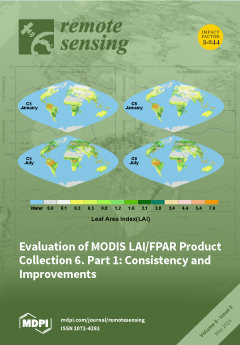Remote Sens., Volume 8, Issue 5 (May 2016) – 84 articles
The science team aims to refine the datasets by updating product cohorts. Collection 6 (C6), as the latest version, has been distributed since 2015. We compare C6 and C5 to check for consistency and discuss the improvements of C6. Global and seasonal comparisons indicate good continuity and consistency for all biome types.
Moreover, inter-annual anomalies of C5 and C6 at regional scale agree well, which imbues confidence in the new dataset. C6 benefits from the improved calibration algorithm which reduces the sensor degradation effect. Thus, some C5-based analysis should be revisited using C6 data. View this paper
- Issues are regarded as officially published after their release is announced to the table of contents alert mailing list.
- You may sign up for e-mail alerts to receive table of contents of newly released issues.
- PDF is the official format for papers published in both, html and pdf forms. To view the papers in pdf format, click on the "PDF Full-text" link, and use the free Adobe Reader to open them.





